Content
The types and varieties of steep sap, which are currently in the possession of decorative gardening, are represented by a rather large list of names. The love of florists and designers for this semi-shrub (less often herbaceous) plant is not surprising.
As a rule, birchwood is a perennial, whose dense, spreading shoots perfectly keep their shape and allow you to create picturesque tall thickets in the garden. It blooms for a long time, on average from July to September, abundantly and very beautifully. Against the background of dark green foliage, magnificent clouds of many small brightly colored flowers bloom during this period. They are grouped into complex guards, umbrellas, or brushes.
Even after the flowering ceases, the stethoscope invariably remains decorative: the obsolete buds, drying out, acquire a silvery-white color and continue to serve as a decoration of the site. If we add to all this a light pleasant aroma, unpretentious care, excellent winter hardiness, many interesting forms and the ability to harmoniously combine with a huge number of ornamental plants, it becomes clear why more and more gardeners are showing sympathy for this flower.
Types and varieties of stethoscope: names with photos
The genus Poskonnik (in Latin Eupatorium), belonging to the Asteraceae family, includes, according to various sources, from 36 to 150 species of herbs and shrubs described by botanists. At the same time, scientists have no consensus about another 200 plant names. Some attribute these species to Eupatorium, while others distinguish and group them into separate genera. To this day, the systematization of steep-sills remains the subject of scientific discussions.
Presumably, this plant comes from North America. More than 5 million years ago, one of the groups of its species migrated from this continent to Eurasia. In addition, in the wild, this flower is also found in Tropical Africa.

Bone sap is a tall, unpretentious perennial with straight, strong shoots and bright small flowers
Nowadays, the types of steep slopes are often classified as follows:
- North American - the most numerous group;
- European (the most famous of them is hemp steep);
- Asian.
Other common among the people Russian names for the steeple are: fog, haberdasher, petishnik, sedasha, horse grass, horse mane. In America this plant is called "Joe Pye Weed". That was the name of the legendary Indian healer who successfully treated typhoid fever, which raged in New England with an extract from the bone marrow.
It is worthwhile to get acquainted in more detail with the most common types of this plant and varieties derived from them that are popular in ornamental gardening.
Tubular
Bone sap tubular or fistulous (lat.Eupatorium fistulosum) is a representative of the North American group of species. The height of its shoots is 0.6-2.1 m (on soils that remain moist throughout the season, they can grow more than 3.5 m).Smaller lateral ones extend from the massive central stem. The color of the shoots of this species can be bright green or light burgundy.
The broad, lanceolate dark green leaves of this bristlecone are collected in whorls of 4-6 pieces around a straight stem, hollow inside. Their length is about 25 cm. The surface of the leaf blade is smooth, the edge is serrate.
Vast arrays of flowers reach about 30-45 cm in diameter. They consist of many individual inflorescences, domed or bullet-shaped, on thin twigs. Each of them unites from 5 to 7 small (0.8 cm) lavender-pink or purple flowers. The period of their appearance is from the beginning of July to the end of September.
Massive White (Album)
In the sources, this variety is most often called the white form of the tubular steep Bone Massive White (Eupatorium fistulosum f. Albidus ‘Massive White’). At the same time, synonyms are officially indicated on the website of the RHS (Royal Society of Gardeners of Great Britain), under which this plant can also be found:
- stethoscope tubular Album (Eupatorium fistulosum ‘Album’);
- Skeleton spotted Album (Eupatorium maculatum ‘Album’).
Obviously, this is the result of the fact that this variety, like many other birch trees, is an interspecific hybrid. In this regard, it can be attributed to either one or another species, depending on the view of the researcher on which of them predominates in this plant. A similar situation has developed with some other varieties of birchwood, therefore, their botanical definitions in different sources may differ significantly.
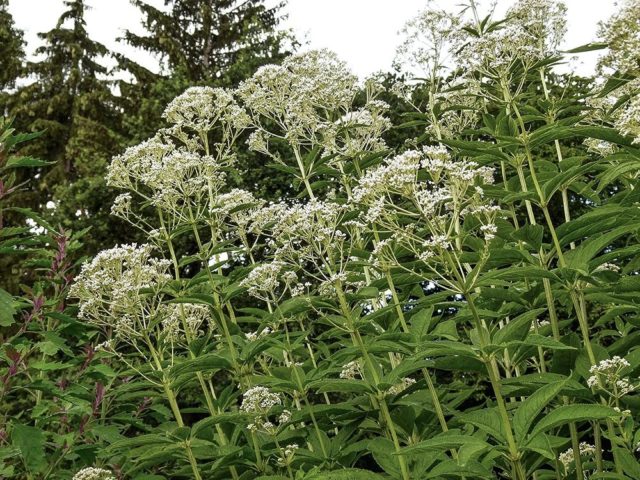
Massive White, a tall, white stew, is also often found under the name Album.
Massive White, or Album, is a dense herbaceous perennial. The height of its bush is usually 1.5-2.5 m, although there are also specimens, the growth of which reaches 3 m. The width of the plant is usually from 0.5 to 1 m. Its leaves are large, yellow-green in color, the plates have a serrated edge. Blooms late (August-September). Lush wide inflorescences are composed of white flowers. Possesses good disease resistance.
Bartered bride
Barthed Bride (Sold Bride) tubular stems are characterized by strong, vertical stems of yellowish-green color, on which light purple stripes are sometimes noticeable. The bushes of the plant reach 2.3 m in height and 1.1 m in width. Inflorescences are white, up to 23 cm in diameter.

Lush snow-white inflorescences of Bartered Bride resemble a wedding dress of the bride
Ivory towers
The variety of steep sap with the poetic name Ivory Towers (Ivory Towers) is famous for its milky white flowers and pale green stems. The height of the plant is 1.7 m, the width of the bush is about 0.75 m. The diameter of the inflorescence is 25 cm. The disadvantage of this variety of steeple is vulnerability to powdery mildew. Another important nuance noted by the specialists of the Chicago Botanical Garden: dying flowers acquire a brownish tint, and the snow-white mass at times looks "dirty".
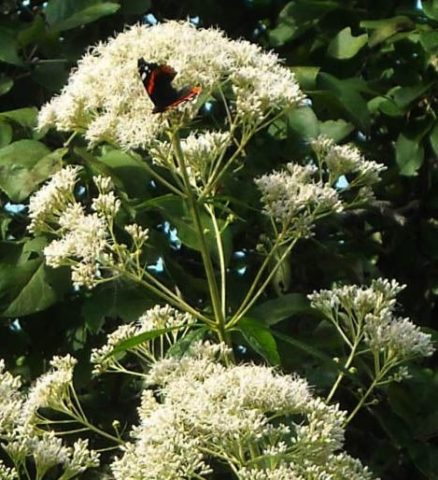
Milky-white domes of Ivory Towers flowers on high stems look like majestic towers
Carin
The height of the bushes of the variety of bone marrow tubular Karin is more than 2 m, their width is about 1 m. The stems of the plant are dark purple, the flowers are pale pink, grouped in inflorescences with a diameter of about 22 cm. The flowering period is from early August to early September.
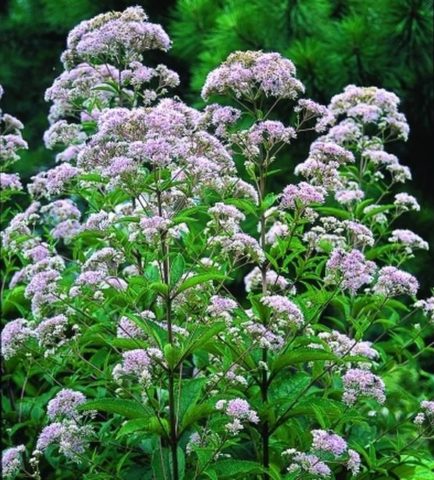
Delicate beauty Karin blooms in dark purple
Selection
A massive plant reaching 1.8 m in height and 1.2 m in width. The sturdy stems of the Selekshen tubular steak are painted in wine-burgundy tones. Its dense clusters of inflorescences are usually about 40 cm in diameter. The flowers are white or purplish white and attract many butterflies. You can admire them from early August to mid-September.

Selekshen is a relatively young variety with wine-red tones typical for the color of the flowers.
Spotted
Spotted sap (lat.Eupatorium maculatum) naturally grows in Canada, as well as in the central and northern parts of the United States. This is a large herbaceous plant, the bush of which reaches 1.8-2 m in height. Shoots are straight, powerful, violet-green in color. The leaves are whorled on them. The plates are large, dark green, elongated, with a slightly pubescent surface and jagged edges.
Inflorescences are large, almost flat. The color of the opened brushes depends on the variety and can vary from white to purple. Flowering begins at the end of July. It lasts about a month.
Below are some of the brightest varieties of this stethoscope.
Atropurpureum
The stems of the stellate variety Atropurpureum are dark purple in color (sometimes even spotted), and the opened tubular flowers are very bright, mauve. They are collected in vast inflorescences with a diameter of 25 cm.The average height of the shoots is 1.7 m, the width of the bush is about 1.5 m.

One of the most famous ornamental varieties of stethosis is Atropurpureum
Gateway
The sizes of the stethosis of the spotted Gateway (Gate) can vary widely. The average plant height of this variety is about 2 m, width - 1.5 m. The inflorescence often reaches 30 cm in diameter. Shoots of the Gateway variety are painted in deep wine-red tones. The unopened buds are usually lilac shades, and the small flowers are purple-pink, which creates a beautiful transition. It is believed that this hybrid grows more compact in comparison with many other varieties of broomstick, its bushes are denser, and the inflorescences are denser.

Charming Gateway combines lilac and purplish pink
Phantom
The phantom variety is not as tall as the sprawling variety: its shoots usually stretch upward by 0.8-1.3 m, while the width of the bush is on average 1.6 m.Thanks to this feature, it is grown not only in open ground, but also in large containers. Large buds of inflorescences, opening in the middle of summer, allow you to admire the mauve flowers, which look very elegant against the background of bright green foliage. This variety of steak is great when cut.

Delicate pink airy inflorescences of the Phantom add a ghostly mystery to his image
Purple bush
Bush sap Purple Bush (Lilac Bush) lives up to its name: its lilac-pink flowers are similar to the previous two species. However, the size of its inflorescences is slightly smaller than that of the Gateway variety, about 22 cm, and the height of the bush is only 1.2-1.5 m with a 1.2-meter width. On the stems, black-crimson longitudinal stripes are usually clearly visible.

The dense Purple Bush will transform any sunny spot in the garden into a secluded corner.
Little red
The varietal steak of the spotted Little Red (Red Kid) is distinguished by its relatively compact size: 1.2-1.7 m in height and 0.6-0.9 m in width. Its stems are pomegranate purple in color, and the leaves are green. Vast arrays of pale pink flowers reach 25 cm in diameter.
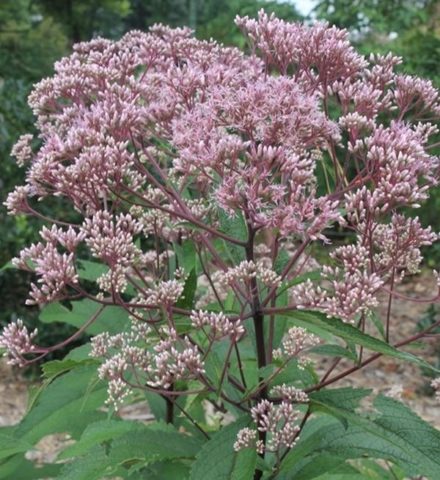
Little Red is low only in comparison with other slopes: its bush can grow up to 1.7 m
Purple
In terms of its main characteristics, the purple stew (Latin Eupatorium purpureum) is very similar to the previously described species - spotted. Experts at the Chicago Botanic Garden note that gardeners often confuse them or interpret them as synonyms.
A characteristic feature of purple stethosis is a green stem, smooth or covered with few hairs, not hollow inside, with purple spots only in the places of nodes. Leaves are matte, oval-lanceolate, with a jagged edge. They are assembled in whorls of 3 or 4 pieces. Sweet-smelling lavender flowers are combined into inflorescences about 30 cm across.On high (1.7-2.5 m) strong shoots, they appear in the middle of summer and decorate them until the beginning of September.
Little joe
Hybrid Little Joe, or Baby Joe, in most cases, is considered a dubious stethoscope (lat.Eupatorium dubium). At the same time, some scientists assume that this is a variety of purple stethosis. In the descriptions provided by plant nurseries, you can often find both such and such options.
The bush of this variety does not grow very large - only 1-1.2 m in height and about 0.9 m in width. Little Joe's flowers are smoky pink, leaves are slightly rough, dark green. Shoots usually grow very densely. Flowering begins in August and lasts 2-3 weeks.
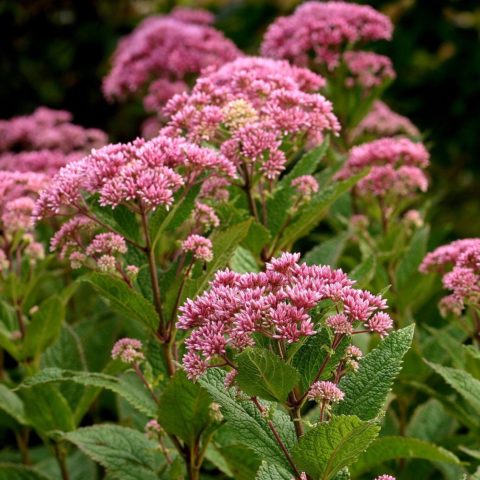
Little Joe's inflorescences are painted in a beautiful smoky pink color
Baby joe
Baby Joe (Little Joe) is a relatively young hybrid of Dutch origin. Like the previous variety, it is often referred to as a dubious stethoscope, although there are opinions that in fact it is purple.
This is a low-growing compact bush, whose height is 0.6-0.9 m and a width of 0.3-0.6 m. Its leaves are dark green in color. The diameter of the corymbose inflorescence is about 13 cm. The flowers of this variety are purple-pink.
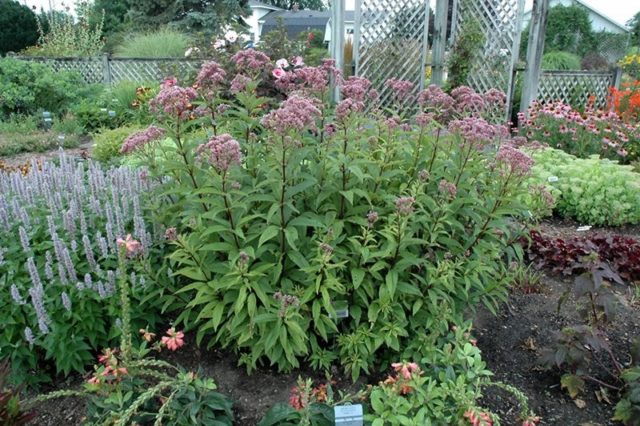
"Tiny" Baby Joe is considered a dwarf sap
Euphoria Ruby
Stem purple Euphoria Rabi (Euphoria Ruby) is a compact plant, usually not exceeding 0.75-1.2 m. The inflorescences of this variety are red-purple in color, the leaves are dark green. The stems are straight.
The Euphoria Ruby patent contains information that this hybrid has a certain similarity to Little Joe. However, this variety is distinguished by less tall bushes, a darker purple shade of color of flowers and wider leaf blades.
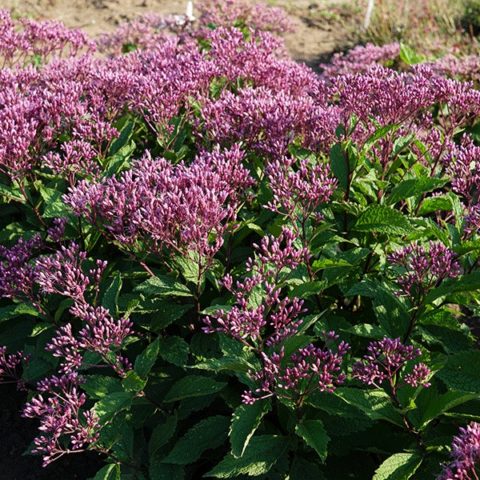
Euphoria Ruby petals play in the sunlight like the edges of a jewel
Hemp
Hemp sap (Latin Eupatorium cannabinus) is found almost everywhere in Europe.
For this species, a straight, relatively low stem is typical (0.2-0.5 m, sometimes it can exceed 1 m). The leaves have short petioles, oppositely arranged. The plates are finger-dissected into 3 or 5 segments, their surface is slightly pubescent. Inflorescences are collected in corymbose panicles at the tops of the shoots. The flowers are pink.
Hemp sap is a melliferous plant, however, honey from plants of this species, as a rule, is not eaten. The flowering period is the second half of summer.
Album Plenum
Album Plenum is a cannabis steep variety that blooms with white or almost white flowers. The height of the bush is about 1.25 m. The flowering time is from July to September.
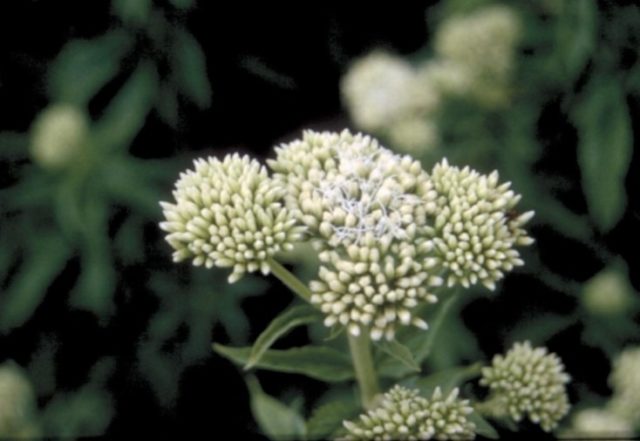
Album Plenum is a white-flowering hemp variety
Flore Pleno (Plenum)
Flore Pleno (aka Plenum) is an unusual terry form of hemp steep. The variety is famous for its double flowers of bright pink color. The leaves are rich green. The height and width of the bush can be 1-1.5 m.
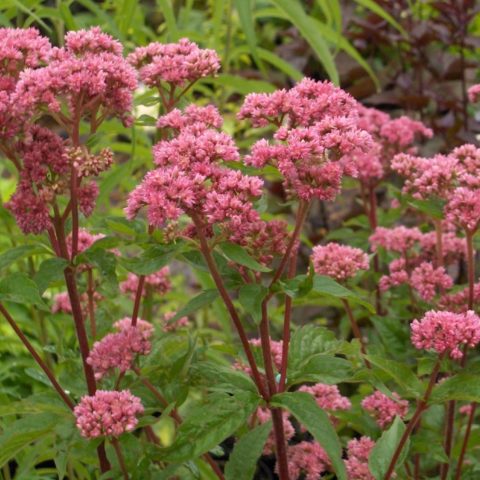
Flore Pleno became famous for its unusual double flowers
Wrinkly
The wrinkled sapstone (lat.Eupatorium rugosa) is currently renamed to ageratina the highest (lat. Ageratina altissima) and transferred to the genus Ageratin. However, nurseries often offer this plant under the same name.
Distinctive features of this type of steep sternum are straight, vertically directed shoots no more than 1.5 m high. The stems are relatively weak and usually require support. Leaves are oval or heart-shaped, have a pronounced jagged edge, are located opposite. Inflorescences are corymbose, dense. The color of the petals is white or light cream. The flowering period begins late, in September-October. In temperate climates, it may not bloom at all.
Chocolate
The most famous variety of wrinkled steak is Chocolet (Chocolate). Its glossy leaves are famous for their unusual color: dark green with purple-brown tint.Young foliage and the underside of the plates have a purple tint. They are beautifully contrasted with the creamy white flowers that usually appear in October.
The height of the Chocolet bush is about 1 m. This variety is frost-hardy and tolerates small negative temperatures well.
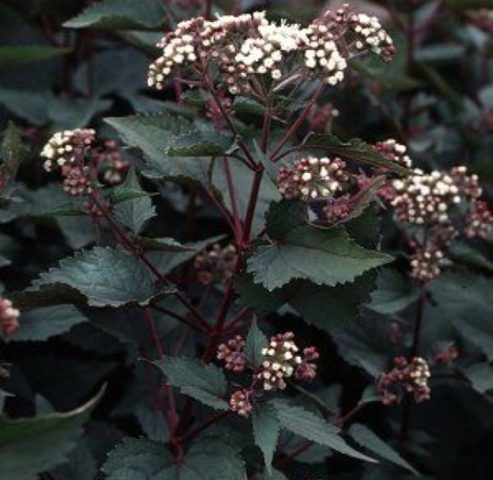
In the color of the leaves of the Chocolet variety, a dark green color is combined with a red-chocolate
Braunlaub
Bone sap Brownlaub wrinkled grows to 0.8-1 (according to some sources - up to 1.5) m. It is characterized by rich green leaves with a pronounced bronze-brown tint and white flowers. It grows densely, forms dense bushes.

Brownlaub foliage casts a bronze brown
Lucky melodie
Lucky Melody (Happy Melody) is a compact, undersized hybrid variety of wrinkled steak. It reaches only 0.4-0.5 m in height. The color of the leaves is green, the inflorescences are snow-white. The flowering period is August-September.
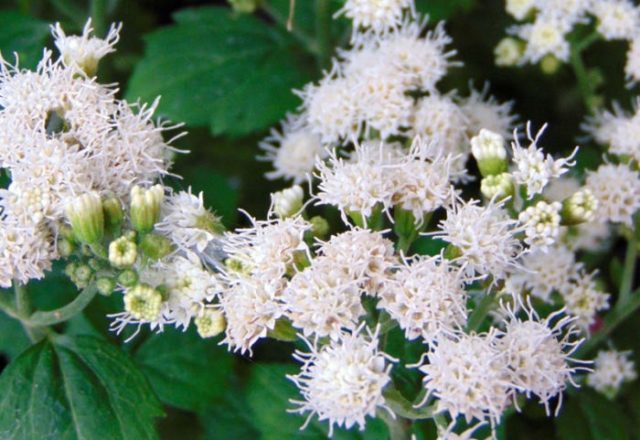
Lucky Melody, blooming white - a very small variety of steep, no more than 0.5 m in height
Fortune
Eupatorium fortunei is a species of Asian origin. Its height usually varies from 0.4 to 1 m. Stems are straight, colored green or red-brown. They branch slightly and are covered with a sparse downy. The length of the leaves is about 10 cm. The plates are elliptical-lanceolate, divided into 3 parts. Their edge is asymmetrically serrated.
The diameter of the combined inflorescences is usually 3-6 (sometimes up to 10) cm. The color of the flowers is varied: from white to reddish. They have a pleasant scent reminiscent of lavender.
Capri
The steepless variety Fortune Capri is quite compact - only 55-60 cm in height and about 45 cm in width. This allows you to successfully grow it as a pot culture. Its leaves are elongated, feathery, slightly wavy. They are painted in emerald green and pinkish tones. A beautiful creamy-cream border along the edge of the plates adds even more decorative effect to them. The inflorescence heads are small, rounded, lavender-pink in color. Flowers appear from mid-August to late September.
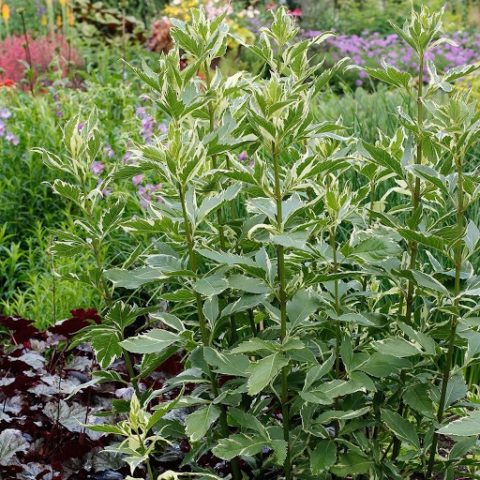
Stem Fortune Capri is distinguished by unusually colored leaves with a white border around the edges.
Pink frost
Fortune's rosewood Pink Frost (Pink Frost) grows high - up to 1.2 m. In width, the bushes of this variety reach 0.7 m. The leaves are colored deep green with a creamy white border along the edge. Inflorescences are small. The flowers are small, bright pink. They can be seen quite late: in August-September.

Pink Frost's bright bicolor leaves look very decorative
Perfoliate
Bone sap or perforated (lat.Eupatorium perfoliatum) is another species from the North American group. Has a straight stem, about 1 m in height. The leaves are elongated, oppositely located on the shoots. They can be triple or whole. Baskets of 3-7 small white flowers form dome-shaped common inflorescences. This herb is considered medicinal. Flowering time is from July to September.
JS Witte Walken
Jay Es Witte Volken bush bush was bred by the Belgian Jan Sprayt in 2015. It grows to 0.7-1 m in height and about 0.4 m in width. The leaves of this variety of stethosis are characterized by a green color, while the flowers are white. The flowering time of the plant is from July to September. During this period, it attracts a large number of bees and butterflies.
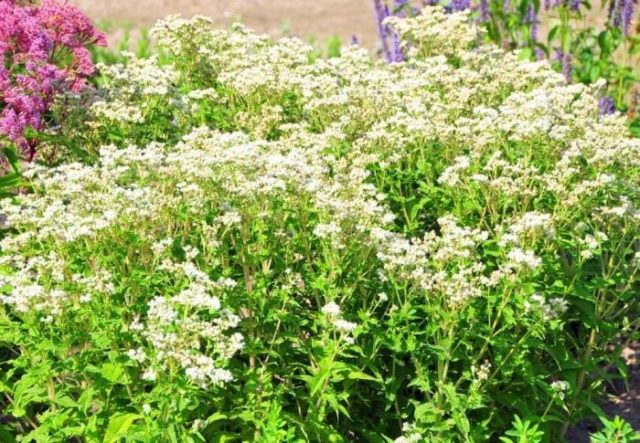
The shoots of the JS Witte Walken variety grow densely and luxuriantly
Milk And Cookies
Bone Sap Milk End Cookies (Milk With Cookies) was first introduced by Intrinsic Perennial Gardens Inc. (By the Association of Botanic Gardens Growing Native Perennials) in 2014 in Illinois, USA. This variety owes its name to the milky white flowers that appear in late summer and contrast with the unusually colored chocolate brown foliage. Under optimal conditions for it, the bush can grow up to 0.9 m in height and 0.6 m in width.

Based on the seedling of the Milk End Kukiz variety (left), a new hybrid was bred in 2020 - Polished Brass (right)
Care rules
Any of the varieties of stethosis intended for the garden are hardy and unpretentious. It grows quickly, does not require shaping pruning and frequent transplants, and also practically does not suffer from diseases and pests.
However, caring for this perennial still has certain subtleties that it is desirable to take into account:
- The site on which the bush is to grow, it is advisable to choose a well-lit and located in an open place. Its area must be at least 1 sq. m. It is preferable that the soil is loose, fertile and has neutral acidity.
- Sapwood is a moisture-loving plant. Water it abundantly and often, especially in summer, on hot dry days. The better the soil is moistened, the higher the shoots will grow. After watering, the soil at the roots of the steep should be loosened.
- Top dressing is optional. Optionally, you can fertilize the plant with complex mineral compositions 2-3 times per season.
- Some species and varieties of steep sap need to tie the shoots to the supports.
- It is recommended to promptly remove wilted inflorescences to prevent self-seeding.
- Most varieties of steep-sap are frost-resistant and winter well in the area without shelter. Before the onset of cold weather, the ground part of the bush is cut off.
- The sapwood can grow in the same place for up to 10 years without losing its decorative qualities. If necessary, dig up and divide an adult bush should be in spring or autumn.
Sap in the landscape
The species and decorative varieties of this powerful, spectacular-looking, lush-flowering perennial can be a real boon for the embodiment of various design ideas.
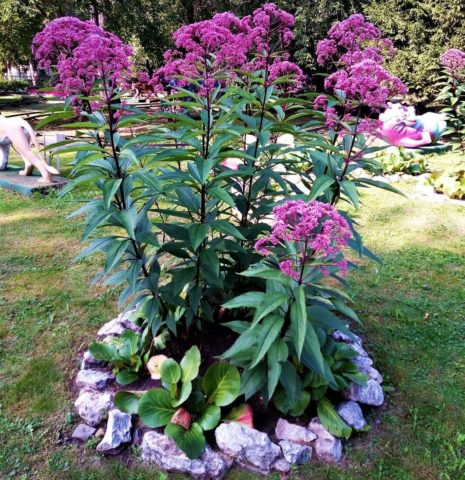
A bush of a tall variety of steep sap will perfectly act as a tapeworm on a lawn or lawn, attracting everyone's attention, its lush inflorescences will look especially bright against the background of lush green grass

This plant is moisture-loving and will be a win-win solution in the design of the coast of a decorative reservoir
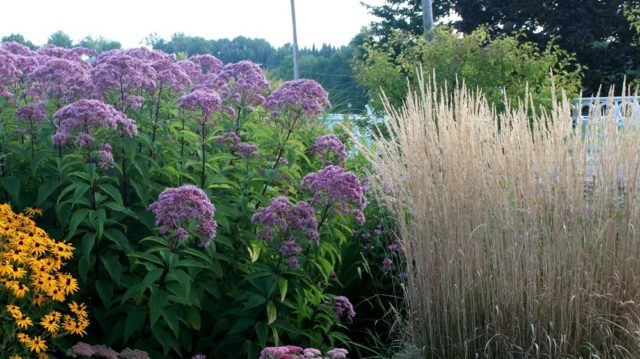
Brightly flowering varieties of stethosis are wonderfully suitable for mixed beds with the participation of tall ornamental cereals, as well as flower crops in harmony with its color: heleniums, heliopsis, rudbeckia, goldenrod, astilba, paniculate phlox, buzulnik, echinacea

Powerful, high-pitched sill looks great as a background or background in multi-level group compositions

Planted against the wall of a house, near a hedge or near any building, this handsome man will be an excellent decoration for it.
Conclusion
The types and varieties of steep sap that can be successfully grown as ornamental crops are very beautiful and diverse. A tall, wildly bushy, unpretentious perennial, decorated with lush clouds of bright small flowers since mid-summer, will be an excellent solution for decorating various corners of the site. The main thing is to land the steep-sirloin in a well-chosen place and provide him with the necessary minimum of care. Then this tall handsome man will be able to truly transform the garden.








